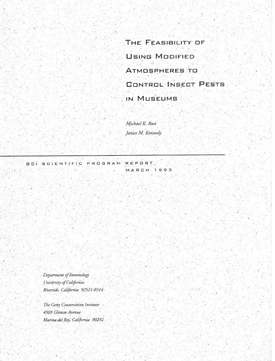
The Feasibility of Using Modified Atmospheres to Control Insect Pests in Museums
Michael K. Rust and Janice M. Kennedy
1993
132 pages
PDF file size: 1.99 MB
Description
Surveys of natural history and art museums indicate that beetles belonging to the families Anobiidae and Dermestidae and moths belonging to the family Tineidae are major pests. Other groups such as termites and silverfish may also be extremely important, especially in Southeast Asia. Current control recommendations include the use of space fumigation or surface residual spraying. In addition to the need to train museum personnel to use these insecticides, there is always the potential for damage to rare antiquities and artifacts. The primary objectives of this study were to determine: (1) if controlled or modified atmospheres were lethal and (2) to establish the minimum time required to provide 100 percent kill of all developmental stages of insects likely to infest materials, objects, and artifacts in museums.
Table of Contents
- Introduction
- Test system
- Insects
-
1. The Webbing Clothes Moth
- Results
- Conclusions
-
2. The Furniture Carpet Beetle
- Results
- Conclusions
-
3. The Firebrat
- Results
- Conclusions
-
4. The Cabinet Beetle
- Results
- Conclusions
-
5. The Larder Beetle
- Results
- Conclusions
-
6. The Cigarette Beetle
- Results
- Conclusions
-
7. The Confused Flour Beetle
- Results
- Conclusions
-
8. The American Cockroach, Brownbanded Cockroach and German Cockroach
- Results
- Conclusions
-
9. The Powderpost Beetle
- Results
- Conclusions
-
10. The Western Drywood Termite
- Results
- Conclusions
- Summary
- Acknowledgments
- References Cited